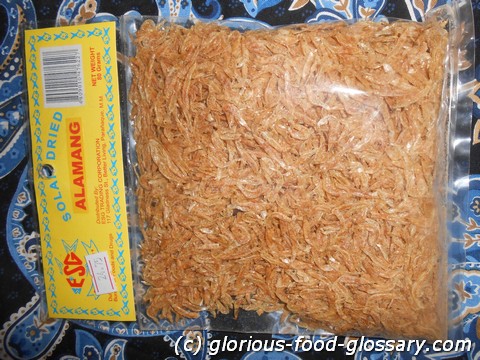Deutsch: Getrocknete Alamang / Español: Alamang seco / Português: Alamang Seco / Français: Alamang séché / Italiano: Alamang essiccato
Dried Alamang in the food context refers to tiny, dried shrimp that are a staple ingredient in many Southeast Asian cuisines, particularly in the Philippines. Alamang is known for its intense flavor, which is both salty and slightly fishy, making it a popular choice for adding depth and umami to various dishes. This ingredient is derived from small shrimp or krill that are salted and then dried under the sun to preserve them.
Description
The use of Dried Alamang is prevalent in Filipino cuisine, where it is often used as a flavoring agent in dishes such as stir-fries, soups, and dips. It can be ground into a powder, used whole, or turned into a paste to add a distinctive taste to recipes. In addition to its culinary uses, dried alamang is also appreciated for its nutritional content, including proteins and minerals, making it a beneficial addition to many meals.
Application Areas
Dried Alamang finds its application in various culinary preparations, such as:
- Seasoning: It can be used whole or ground as a seasoning for dishes, adding a burst of umami and saltiness.
- Sauces and Pastes: Often incorporated into sauces and pastes to enhance their flavor profile.
- Toppings: Sprinkled over dishes as a garnish to add texture and a savory taste.
- Integral Ingredient: Used in traditional Filipino recipes like Pinakbet (a vegetable stew) and Bagoong Alamang (a fermented shrimp paste).
Well-Known Examples
Some well-known dishes that utilize Dried Alamang include:
- Ginisang Monggo: A Filipino mung bean soup where dried alamang is sautéed along with garlic, onions, and tomatoes to add flavor.
- Pako Salad: A fern salad that may feature dried alamang as a topping for an added salty crunch.
- Bagoong Alamang: Although not made from dried alamang directly, this fermented shrimp paste represents a related use of small shrimp in Filipino cuisine.
Recipes
A simple recipe that features Dried Alamang is a basic sauté:
-
Ingredients:
- A handful of dried alamang
- Minced garlic
- Chopped onions
- Diced tomatoes
- Cooking oil
- A splash of vinegar (optional)
-
Preparation:
Treatment and Risks
When consuming Dried Alamang, it's important to consider its high salt content, which can contribute to increased blood pressure and other health issues if consumed in large quantities. As with all dried seafood, ensuring it comes from a clean, uncontaminated source is crucial to avoid potential health risks.
Similar Terms or Synonyms
- Dried shrimp
- Dried krill
Summary
Dried Alamang is a versatile and flavorful ingredient widely used in Filipino cuisine and other Southeast Asian dishes. Its salty, umami-rich profile enhances the taste of various recipes, from soups and salads to sauces and pastes. While nutritious, its consumption should be moderated due to its high salt content.
--

Related Articles to the term 'Dried Alamang' | |
| 'Shrimp paste' | ■■■■■■■■■■ |
| Shrimp paste is a fermented condiment made from ground shrimp or krill that is mixed with salt and left . . . Read More | |
| 'Belacan' | ■■■■■■■■■■ |
| The term Belacan refers to a traditional fermented shrimp paste widely used in Southeast Asian cuisine, . . . Read More | |
| 'Alamang' | ■■■■■■■■■■ |
| Alamang refers to the Filipino word for \'tiny shrimps\'. It is often used to make fermented sauce called . . . Read More | |
| 'Bagoong' | ■■■■■■■■■■ |
| Bagoong is the Filipino term for fermented shrimps or fish, There are different varieties of Bagoong . . . Read More | |
| 'Calamansi' | ■■■■■■■■■■ |
| Calamansi in the food context refers to a small, citrus fruit native to the Philippines and other Southeast . . . Read More | |
| 'Tinapang Tamban' | ■■■■■■■■■■ |
| Tinapang Tamban refers to smoked Tamban, a type of small sardine-like fish that is widely consumed in . . . Read More | |
| 'Bagoong alamang' | ■■■■■■■■■ |
| Bagoong alamang is a Filipino condiment made from tiny fermented shrimp or krill, known as alamang, mixed . . . Read More | |
| 'Ginataang Labong' | ■■■■■■■■ |
| Ginataang Labong in the food context refers to a traditional Filipino dish made from bamboo shoots (labong) . . . Read More | |
| 'Loofah' | ■■■■■■■■ |
| Loofah in the food context refers to the edible fruit of plants in the genus Luffa, particularly the . . . Read More | |
| 'Hamonado' | ■■■■■■■■ |
| Hamonado is a Filipino dish known for its sweet and savory flavors, primarily made with pork. The term . . . Read More | |
